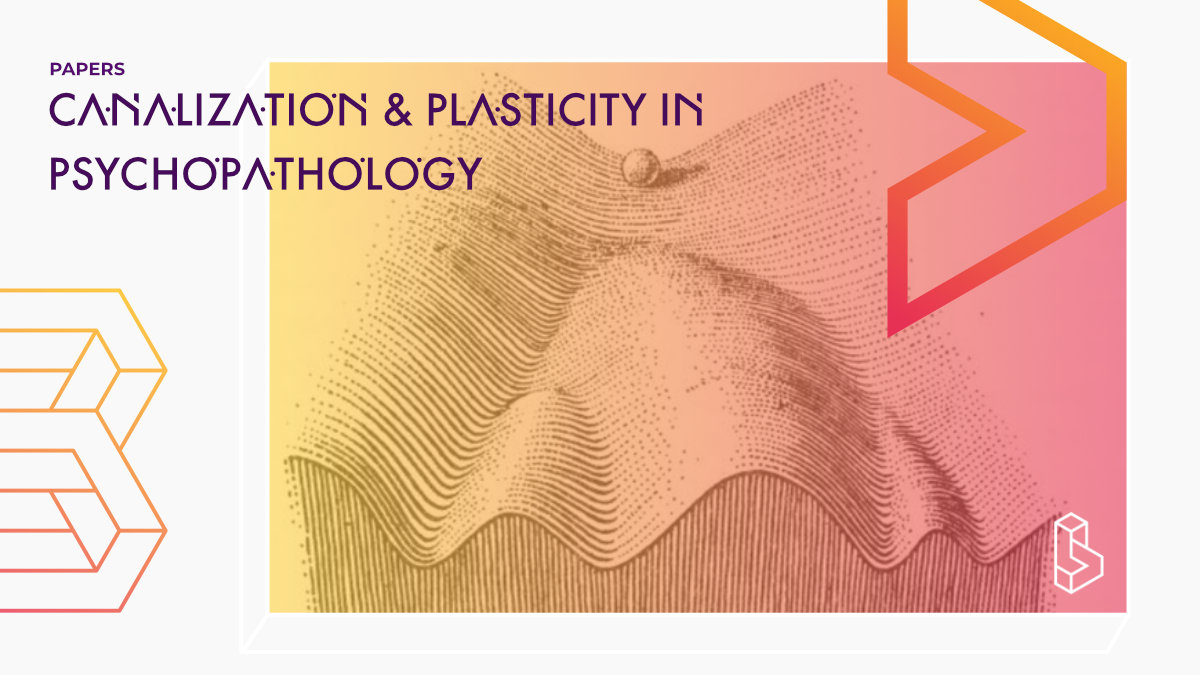This theory-building paper (2022) introduces a new model of psychopathology called canalization, which is a form of plasticity that relates to increased model precision. It suggests that TEMP, combined with psychological support, can counter the entrenchment of canalization in pathological phenotypes, and offers suggestions for experiments to test its main hypotheses and implications.
Abstract
“This theoretical article revives a classical bridging construct, canalization, to describe a new model of a general factor of psychopathology. To achieve this, we have distinguished between two types of plasticity, an early one that we call ‘TEMP’ for ‘Temperature or Entropy Mediated Plasticity’, and another, we call ‘canalization’, which is close to Hebbian plasticity. These two forms of plasticity can be most easily distinguished by their relationship to ‘precision’ or inverse variance; TEMP relates to increased model variance or decreased precision, whereas the opposite is true for canalization. TEMP also subsumes increased learning rate, (Ising) temperature and entropy. Dictionary definitions of ‘plasticity’ describe it as the property of being easily shaped or molded; TEMP is the better match for this. Importantly, we propose that ‘pathological’ phenotypes develop via mechanisms of canalization or increased model precision, as a defensive response to adversity and associated distress or dysphoria. Our model states that canalization entrenches in psychopathology, narrowing the phenotypic statespace as the agent develops expertise in their pathology. We suggest that TEMP – combined with gently guiding psychological support – can counter canalization. We address questions of whether and when canalization is adaptive versus maladaptive, furnish our model with references to basic and human neuroscience, and offer concrete experiments and measures to test its main hypotheses and implications.“
Authors: Robin L. Carhart-Harris, Shamil Chandaria, David E. Erritzoe, Adam Gazzaley, Manish Girn, Hannes Kettner, Pedro A. M. Mediano, David J. Nutt, Fernando E. Rosas, Leor Roseman, Chris Timmermann, Brandon Weiss, Richard J. Zeifman & Karl J. Friston
Summary of Canalization and plasticity in psychopathology
This theory-building article revives a classical bridging construct, canalization, to describe a new model of a general factor of psychopathology. It proposes that canalization is a defensive response to adversity and associated distress or dysphoria, and that Temperature or Entropy Mediated Plasticity (TEMP) – combined with gently guiding psychological support – can counter canalization.
Introduction
The construct of canalization was introduced in biology in 1942 by British evolutionary scientist, Conrad H. Waddington, and can be used in reference to the development of psychopathology.
Canalization does not fit the definition of neuroplasticity because it describes how features of the mind, brain, or behaviour become less able to change in a non-specific way.
The distinction between Hebbian plasticity and associative plasticity is key to understanding the present paper, and requires a reconsideration of some popular assumptions regarding plasticity.
Find this paper
Canalization and plasticity in psychopathology
https://doi.org/10.1016/j.neuropharm.2022.109398
Paywall | Google Scholar | Backup | 🕊
Study details
Authors
Authors associated with this publication with profiles on Blossom
Robin Carhart-HarrisDr. Robin Carhart-Harris is the Founding Director of the Neuroscape Psychedelics Division at UCSF. Previously he led the Psychedelic group at Imperial College London.
David Nutt
David John Nutt is a great advocate for looking at drugs and their harm objectively and scientifically. This got him dismissed as ACMD (Advisory Council on the Misuse of Drugs) chairman.
David Erritzoe
David Erritzoe is the clinical director of the Centre for Psychedelic Research at Imperial College London. His work focuses on brain imaging (PET/(f)MRI).
Manesh Girn
Manesh Girn is a Neuroscience Ph.D. Candidate at McGill University and the Chief Research Officer at EntheoTech. His research involves applying multivariate and network-based analyses to functional neuroimaging data in order to examine relationships between the brain and cognition. My doctoral research is aimed at (i) characterizing the default mode network's role in cognition, and (ii) characterizing the brain mechanisms underlying serotonergic psychedelic drugs. He also creates videos on the latest topics in psychedelic science and under the alias 'The Psychedelic Scientist'.
Hannes Kettner
Hannes Kettner is a Ph.D. student at the Imperial College Centre for Psychedelic Research and a Scientific Officer at MyDelica. He is interested in studying real-world psychedelic use, including ceremonies, retreats, burns, and what we can learn from them about creating a positive set & setting.
Chris Timmermann
Chris Timmerman is a postdoc at Imperial College London. His research is mostly focussed on DMT.
Institutes
Institutes associated with this publication
University of California San FranciscoAt UCSF, there are two research teams dedicated to the study of psychedelics; the Neuroscape Psychedelic Division and the Translational Psychedelic Research Program.
Imperial College London
The Centre for Psychedelic Research studies the action (in the brain) and clinical use of psychedelics, with a focus on depression.

